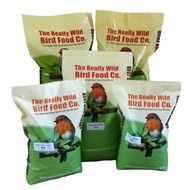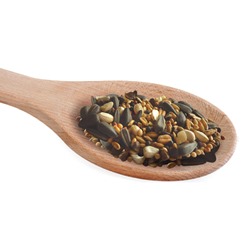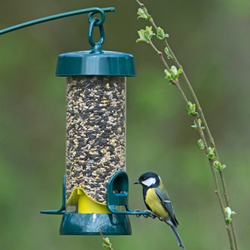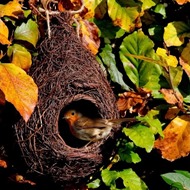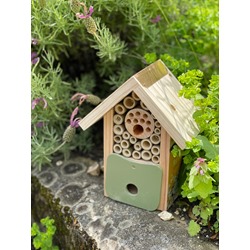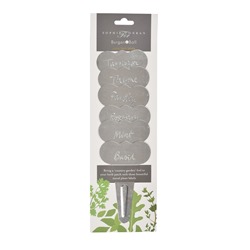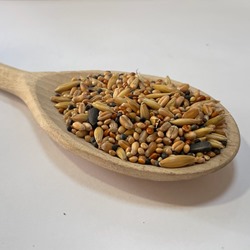
NEWS FROM THE FARM
As I write this, there have been snow flurries here in the south and the temperature has certainly dropped by a few degrees.
October was a lovely month for us; dry and warm, which meant our cover crops grew really well. Our buckwheat flowered for a long time providing some very welcome late nectar for the bees. However buckwheat doesn't like cold weather and it has started to fall over now. The linseed was somewhat slower to flower so didn't provide much late-season help for the bees.
This was Richard's first home produced cover crop and he is very pleased with the mix ratios of the various plants that he put together. This particular cover crop contained the following: oats, phacelia, linseed, buckwheat and sunflowers. Each element with a specific function, contributing to improved soil quality and stability.
- Oats have a deep fine root which hold nitrogen and potash in the soil, and when the plant dies off it provides lots of organic matter for worms, so we see huge numbers of worm casts everywhere :)
- The phacelia will flower for the bees and it also has a shallow, fibrous root which gives a nice tilth for the soil.
- Linseed will flower and its deep root really helps with soil drainage.
- Buckwheat offers a late pollen source for bees and is a good phosphate recoverer. All clever stuff!
This is the first year Richard has direct-drilled his wheat and it is also looking really good. He had previous problems with soil compaction, so this time he ran a sub-soiler with new 'low-disturbance' legs to minimise soil compaction and the wheat looks really well as a result.


BIRDLIFE SPOTTED ON THE FARM
The use of all these cover crops on the farm seems to be having a really positive effect on the birdlife here, which is fantastic news and really heartwarming.
This month we have hosted a large flock of Golden Plover, and Snipe and Woodcock have also been seen. The biggest excitement came when Richard spotted a Lesser Spotted Woodpecker - a reclusive bird that hasn't been seen on the farm for a few years - so we're delighted to know they are in our woods. These photos are obviously not the actual birds because we don't have the photographic skills (or speed of reaction!) to get great shots but nice to visualise what I am talking about.
GOLDEN PLOVER
For the full story, please visit this blog post to read all about Golden Plover.

SNIPE
Snipe are mottled brown, medium sized wading birds with long bills. Numbers increase in the winter months as birds from Northern Europe visit us. They eat small invertebrates, worms and insect larvae and have an Amber conservation status in the UK. There are two types of snipe - the Common Snipe and the much rarer (and very difficult to spot) Jack Snipe. Obviously enjoying the worms on our farm!

WOODCOCK
One of my favourites. Known as 'snipe of the woods', they are elusive, wading birds usually found in woodland. They are pigeon-sized and have a long straight bill. They are really well camouflaged and their crepuscular nature (most active at dawn and dusk) means they can be very difficult to spot! They mainly eat earthworms and beetles. During winter, numbers in the UK are boosted by birds flying in from Europe and Russia. They too are a conservation concern as numbers are declining, probably due to changes in woodland management in the UK.

LESSER SPOTTED WOODPECKER
The most exciting spot of the month for us! The smallest and rarest woodpecker in the UK, and sadly now on the Red list of endangered species. They are very small (slightly bigger than a house sparrow), and it is only the males who sport red colouration; the females are solely black and white. They survive on insects and wood-boring larvae, so the correct woodland habitat is vital to their survival. This one was very fast moving!

 Back
Back Bird Foods
Bird Foods
 Seed Mixes
Seed Mixes Straight Seeds
Straight Seeds Mealworms & Worms
Mealworms & Worms Chicken Feed
Chicken Feed Duck Food
Duck Food Peanuts & Peanut Butter
Peanuts & Peanut Butter Suet & Fat Balls
Suet & Fat Balls No Mess Bird Seed
No Mess Bird Seed Wheat Free Bird Seed
Wheat Free Bird Seed Sunflower Seeds
Sunflower Seeds Softbill Bird Food
Softbill Bird Food Bulk Bird Seed
Bulk Bird Seed Trial Packs
Trial Packs Pick & Mix
Pick & Mix Mini Pick & Mix
Mini Pick & Mix Birdie Basics: Budget Bird Food
Birdie Basics: Budget Bird Food Food for Small Birds
Food for Small Birds Back
Back Bird Feeders
Bird Feeders
 Seed Feeders
Seed Feeders Peanut Feeders
Peanut Feeders Peanut Butter Feeders
Peanut Butter Feeders Suet & Fat Feeders
Suet & Fat Feeders Window Feeders
Window Feeders Hanging Feeders
Hanging Feeders Feeding Stations
Feeding Stations Ground Feeders
Ground Feeders Easy Clean Feeders
Easy Clean Feeders Bird Tables
Bird Tables Seed Trays
Seed Trays Bird Baths & Drinkers
Bird Baths & Drinkers Feeder Accessories
Feeder Accessories Feeder Hygiene
Feeder Hygiene Squirrel Proof Bird Feeders
Squirrel Proof Bird Feeders For the Kids
For the Kids Niger Seed Feeders
Niger Seed Feeders Mealworm Feeders
Mealworm Feeders Bird Food Storage
Bird Food Storage Fat Ball Feeders
Fat Ball Feeders Tube Feeders
Tube Feeders



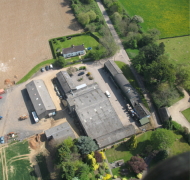 Our Farm
Our Farm
 Tips & Advice
Tips & Advice
Contact Us

